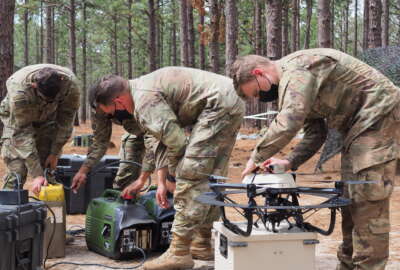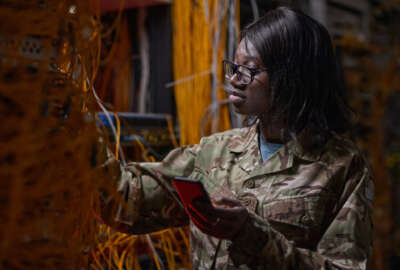
Army explores new paradigm for tech requirements via new model for tactical radios
The Army is asking industry — and itself — whether it truly needs to own and maintain 350,000 high-end tactical radios. Buying simpler radios and leasing the...
The Army owns a whole lot of specialized and fairly expensive radios: around 350,000 of them to be more exact, more than ever in the service’s history. But effectively managing an inventory of communications equipment that large is a huge acquisition and logistics undertaking, and the Army is seriously considering outsourcing a significant part of the problem to industry in its newest potential foray into a technology as-a-service model.
No final decisions have been made yet, but Army leaders think the idea of leasing tactical radios might solve two problems at once: Buying the number of radios Army requirements currently dictate is a massive procurement undertaking in and of itself, and keeping them in working order and secure against enemy forces is an even harder logistical task.
Gabe Camarillo, the undersecretary of the Army, said his service is actively exploring the idea of contracting with a vendor to buy only the number of radios it needs for regular training exercises. Then, notionally, the same company would be in charge of storing, maintaining and upgrading software on the bigger quantities soldiers would need for active military operations, leasing them out to the Army on an as-needed basis.
“The as-a-service model might require us to relook at the processes that we use to fund and to field equipment, and it could also pose some risks to the ability to quickly surge radios and inventory, for example, in the event of a large scale conflict,” he said during one of the Army’s biannual Technical Exchange Meetings in Nashville last week. “The cost savings though, the ability to tailor radio packages to need and the flexibility to provide upgrades over time may nonetheless be a really compelling reason to continue to experiment with this model. Maybe it works, maybe it won’t, but I think we’ve got to try something different, and I’ve challenged our team to place some bets for the future.”
Camarillo said the Army is currently doing its own analysis to help determine how many radios it actually needs at each echelon of its command structure — and what kinds of radios — rather than a one-radio-fits-all-formations approach.
Meanwhile, officials are issuing two separate requests for information to industry: One, expected to be released in the next several days, will ask for companies’ views on the feasibility, possible expense, and wisdom of the overall “as-a-service” notion.
Another RFI, issued Dec. 9, asks for industry input on the possibility of issuing simpler, less-costly single-channel radios to smaller tactical formations. To help reduce costs, the notional radio would use the widely-adopted commercial AES 256 encryption standard, rather than having to comply with military-grade encryption standards certified by the National Security Agency.
Those devices, if adopted, would only be used for the types of communication the Army deems sensitive but unclassified (SBU), said Col. Shermoan Daiyaan, the program manager for tactical radios.
“As an Army, we are looking at where it is acceptable to have SBU. We think it’s around the battalion level and below, and I’ve been asked to look at what that means in cost and what it means in development,” he said. “We think that if that decision is made, then there are different levers we can pull to get after pricing and getting capability out there more quickly. The other thing we’re looking at is the total [basis of issue]. We have a million-person Army, which means every third person could actually have a radio. Some of those radios have different use cases, but we’re asking ourselves, is that correct for the next fight? Many of those were built for a fight that may have been passed. So we’re asking ourselves, does Daiyaan still need that radio, or does he need this radio?”
But in the case of those lower-cost radios, the Army is hoping to get to some initial answers fairly quickly. The RFI indicates officials will want vendors to supply around 30 radios by the end of January so the Army can start testing proofs of concept.
Col. Greg Napoli, the unified network team lead for the Army’s Network Cross Functional Team, said the Army is sure of at least one thing: Whatever solutions it lands on for radios will need to align with its vision for a global unified network.
That plan emphasizes the need for common standards, being able to use any type of transport, and the embrace of new technologies like 5G, software-defined networks and cloud computing.
“The foundational capabilities that this architecture must have — always — is that it’s transport-agnostic, data-centric and security-enabled,” he said. “The waveforms might change, the software might change, the method of delivery or the networking topology might change over time. So we’re not going to lock ourselves into something for 20 years — we need that agile capability — but those pillars have to be the foundation that we work off of, no matter what particular path we choose to address some of the operational challenges.”
Camarillo said since the Army’s not looking to lock itself into a particular technology for decades, a revised approach to tactical radios could help prove out a new paradigm for how the Army defines its technology requirements more generally, beyond the world of radios. In particular, if the capability the Army’s buying is mostly defined by software, it probably won’t make sense to have a traditional sustainment phase as part of the acquisition lifecycle, he said.
“In an industrial age model, if you’re building a tank, you sustain it over many, many years. Once you finish the developmental phase, you just upgrade the hardware over time, and that makes a lot of sense until it reaches the end of its useful life,” he said. “The challenge with a capability that’s primarily software-defined is that the hardware is less important than the software components — that’s where the innovation needs to happen, that’s where the threat vectors lie, and that’s where the emphasis on upgrades is. What we don’t want to do when we’re buying 350,000 radios is to lock ourselves into a particular solution — once we finish buying out that inventory, it becomes cost prohibitive to go back and make significant upgrades and retrofit the entire fleet of tactical radios. This particular requirement could fit very well into a different buying model that could be sustainable over time, and that would make a lot of sense.”
But Camarillo acknowledged there are some big questions and risks involved in moving to an as-a-service model.
“If we needed to surge tactical radios in the event of a contingency operation, how would we ensure that the minimum security upgrades and user enhancements are planned for as part of that buying model? These are all really good questions we have to ask,” he said. “They have a requirements component, they have an industry component, and they have an acquisition process component. So what we’re looking to get from industry is feedback on what they think can be done. But we can’t afford to go into a traditional sustainment phase, because we need to continue to do tech insertion and the software upgrades.”
Copyright © 2024 Federal News Network. All rights reserved. This website is not intended for users located within the European Economic Area.
Jared Serbu is deputy editor of Federal News Network and reports on the Defense Department’s contracting, legislative, workforce and IT issues.
Follow @jserbuWFED





